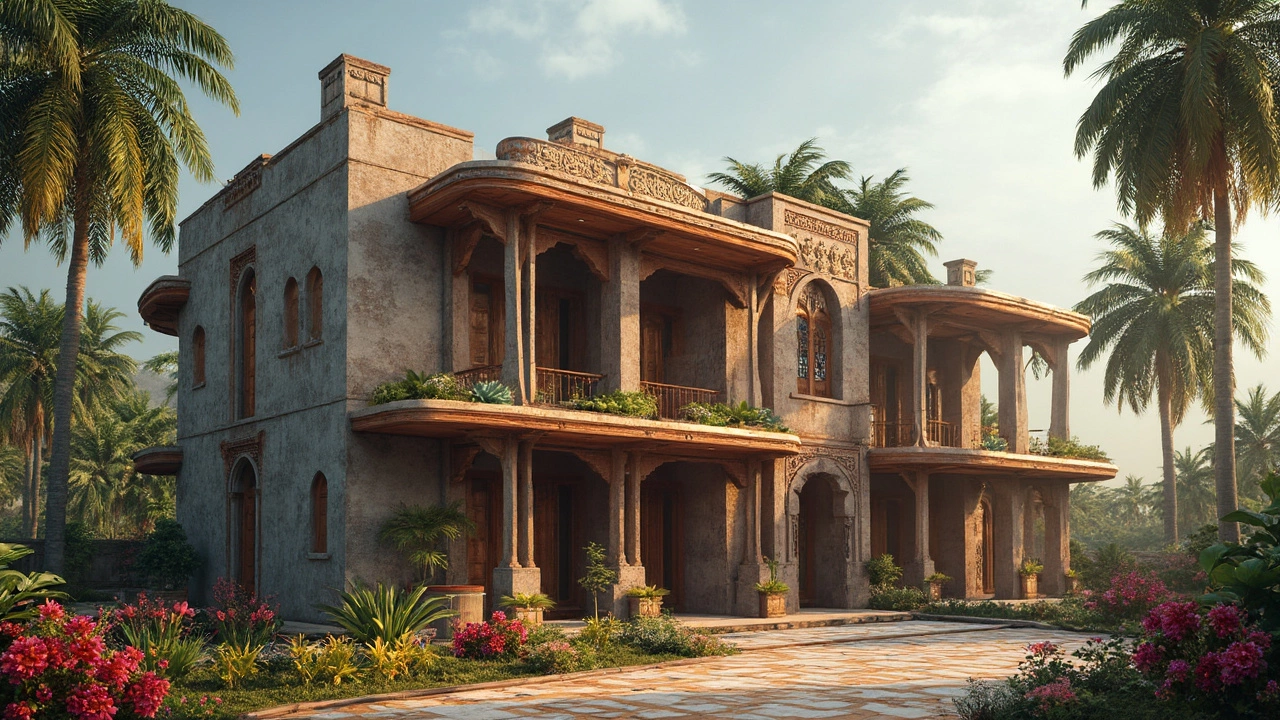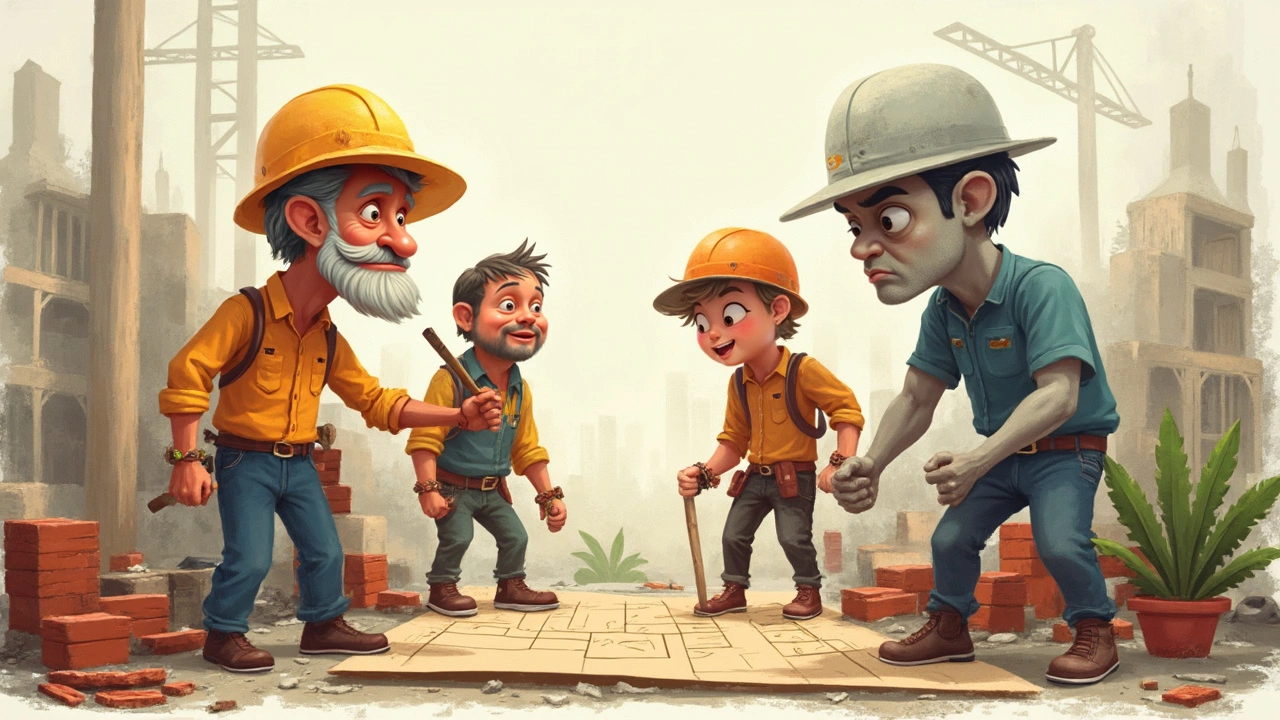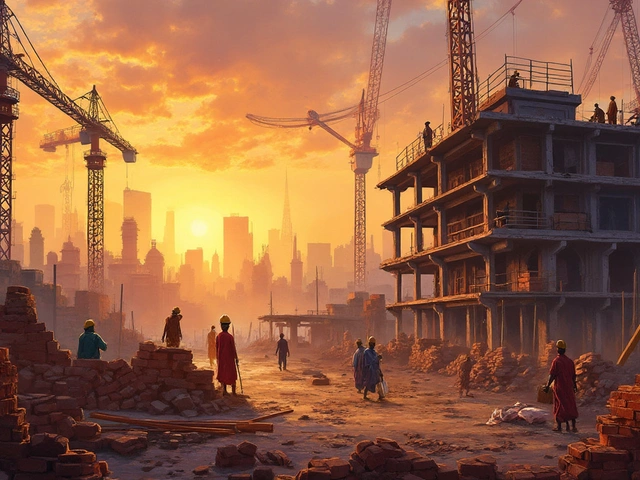So, you're planning to build a house and want it to last, right? Choosing the right material can make or break the longevity of your home. Concrete is often hailed as the champion in durability. If you've ever walked through ancient Roman sites, you'll know concrete can withstand the test of time.
But don't count out other contenders like natural stone and brick. They've been sheltering folks for centuries, proving to be incredibly resilient. And with modern advancements, they're more reliable than ever. If you're considering steel or bamboo, know these are gaining popularity too, especially for their sustainability and innovation appeal.
Each material comes with its own set of perks and downsides. It's not just about picking the longest-lasting one; it's about finding what suits your needs best. Let’s explore the ins and outs of these materials so you can make a solid decision for your future home.
- Why Material Choice Matters
- The Reigning Champion: Concrete
- Classics that Withstand Time: Stone and Brick
- Emerging Alternatives: Steel and Bamboo
- Making an Informed Choice
Why Material Choice Matters
Picking the right construction materials for your home is like picking the right ingredients for a recipe. Get it right, and you’ll have a sturdy, long-lasting home. Choose poorly, and you might end up with expensive repairs down the road.
Durability is a big reason why material choice matters. Think of materials like concrete or stone versus wood. Ever notice how stone and concrete stand the test of time through weather and wear? They don't rot or warp like wood can when exposed to the elements over the years. Plus, tough materials mean fewer costly fixes.
Not just durability, though. Cost-efficiency is another biggie. While some materials might be pricier upfront, they can save you money in the long haul. For example, investing in steel might feel hefty initially, yet you benefit from minimal maintenance costs and long-term structural integrity.
Environmental Impact
Environmental factors should be on your radar too. Modern materials like bamboo are more sustainable, growing quickly and generating less waste. That’s good news if you’re looking for eco-friendly options. It’s a balancing act between durability, cost, and sustainability.
| Material | Average Lifespan |
|---|---|
| Concrete | 75-100 years |
| Brick | 100+ years |
| Wood | 50-100 years |
| Steel | 100+ years |
| Bamboo | 25-50 years |
Your climate plays a role too. If you’re in a wet or hurricane-prone area, picking a durable house building material can save a ton of headaches. On the flip side, those in calmer zones might have more flexibility.
So, consider these factors carefully. Investing time in researching longest lasting materials can lead to a worry-free living experience.
The Reigning Champion: Concrete
When it comes to construction materials that stand the test of time, concrete is the undefeated king. It's a mix of cement, water, and aggregates like sand, gravel, or crushed stone. This potion results in a robust, weather-resistant material that is a construction go-to. Thanks to its remarkable durability and versatility, it's a top choice for builders worldwide.
Concrete is known for its longevity, often outlasting many other building materials. With proper reinforcement, it's not only strong under pressure but also flexible enough to resist cracking. It’s like the heavyweight champion of materials, enduring harsh weather conditions and everyday wear and tear.
Why Concrete Rocks
- Durability: Concrete can last for centuries, and when you factor in its ability to withstand fire, water, and wind, it's easy to see why it's favored.
- Versatility: Have you seen those curvy, artistic modern homes? Yep, that's concrete showing off its flexibility.
- Cost-effective: Long life translates to fewer repair costs over time, making it a budget-friendly option over the long haul.
Real-Life Proof
A quick glance at history shows us some impressive buildings made from concrete. The Pantheon in Rome, built in 120 AD, still stands today—a testament to concrete’s formidable strength.
Recently, concrete has jumped on the sustainability bandwagon. Innovations in its composition, like using recycled materials, make it eco-friendlier. Plus, concrete structures can have cooler interiors, reducing the need for air conditioning and cutting energy costs.
With its unmatched durability and constant innovations, it’s no surprise that concrete continues to lead in the world of house building. It's truly the reigning champion for anyone looking to build a lasting home.

Classics that Withstand Time: Stone and Brick
When we talk about durable materials for houses, stone and brick are the old-school legends. Their staying power isn't just a fluke; it’s all about their natural strength and ability to weather just about anything Mother Nature throws.
Unyielding Stone
Let’s start with stone. This material, used in construction since ancient times, is incredibly strong. From medieval castles that still stand tall today to the pyramids of Egypt, they all showcase stone’s strength. It’s not just about durability but also the minimal maintenance that makes stone a solid choice for homes.Stone is great for insulation, keeping your home cool in summer and warm in winter. A cool fact: the thermal mass of stone allows it to store heat and release it gradually, making it energy-efficient.
The Ever-Reliable Brick
Now, onto bricks. Ever seen an old red-brick building that looks like it’s been there forever? It probably has. Brick has this silent resilience that makes it a favorite. It’s made from clay heated at high temperatures, making it fire resistant and robust against weather-related wear and tear.Bricks are not just about strength; they’re also about style. These bad boys add a classic charm to any home. And let’s not forget, they’re quite easy to work with, and their modular nature makes construction simpler.
One thing to keep in mind, though, is the quality of the mortar that holds these bricks together. While bricks last ages, mortar can degrade faster, so regular checks and maintenance of mortar joints can ensure longer life for your brick structures.
Choosing between stone and brick often boils down to aesthetics and availability. Whether you go for the rustic appeal of stone or the charming look of brick, both these materials promise a home that’ll stand the test of time.
Emerging Alternatives: Steel and Bamboo
When it comes to modern construction, steel and bamboo are making waves as durable, eco-friendly choices. They might not be what you first think of when considering house building, but these two materials have a lot to offer.
Why Steel?
Steel is like the superhero of construction materials. It's incredibly strong yet surprisingly lightweight. This makes it perfect for everything from skyscrapers to residential homes. One major plus is its resistance to pests and rot—say goodbye to termite worries! Plus, it's earthquake-resistant, which is a big deal here in New Zealand where tectonic shifts aren't rare.
Here's a quick look at some steel perks:
- Durability: Can last a lifetime with the right care.
- Eco-friendly: Fully recyclable, making it a green choice for the eco-conscious builder.
- Efficiency: Tracks well with modern eco-friendly architectural designs, often aligning with standards for energy efficiency.
Bamboo: The Green Giant
Bamboo might sound unconventional, but it's been used in Asian construction for centuries. It's incredibly sustainable with a growth rate that can reach its full height in just a few months. Compared to traditional construction materials, bamboo has a much smaller environmental footprint.
Why consider bamboo?
- Renewable Resource: Rapid growth makes it one of the most sustainable materials available.
- Strength: Surprisingly strong, with a tensile strength comparable to steel.
- Flexibility: Bamboo's natural flexibility can handle a bit of wiggle in windy conditions.
While neither steel nor bamboo is the 'perfect' material for every project, they offer exciting possibilities that blend strength with sustainability in some innovative ways. If you're aiming for a future-proof home, these emerging alternatives are worth a closer look.

Making an Informed Choice
Picking the right construction materials for your home isn't just about flipping a coin. There’s a lot more at stake here. It’s about understanding the strengths and weaknesses of each option. So, how do you zero in on the best one for your needs?
Consider Your Environment
A major factor in your decision should be the climate and environment where you’re building. Living in an earthquake-prone area like New Zealand? It’s common knowledge that materials like reinforced concrete and steel are preferred for their durability and resistance to seismic activity. Plus, they handle moisture and temperature fluctuations like a pro.
Look at Longevity and Maintenance
You want to build a house that lasts, and minimal upkeep is a bonus. Materials like brick and natural stone not only offer robustness but also require less frequent maintenance than others, like wood, which might need regular treatments to fend off pests.
Cost vs. Value
We all know budget matters. But focusing solely on upfront costs can be misleading. Instead, think long-term. Spending a bit more initially on materials like steel can save money down the line due to their reduced maintenance costs. Check out this quick breakdown of estimated maintenance costs over 50 years:
| Material | Average Cost (NZD) |
|---|---|
| Concrete | $1,200 |
| Brick | $1,500 |
| Steel | $800 |
Assess Sustainability
In today’s world, being eco-friendly is more critical than ever. Materials like bamboo are emerging as popular alternatives since they're renewable and have a lesser environmental impact compared to traditional options.
The bottom line? Weighing these factors against each other will guide you toward the best choice for your needs. Sure, it takes a bit of time, but getting it right means reaping the benefits for decades to come. Now, let’s get that dream home of yours standing strong and proud!



Write a comment